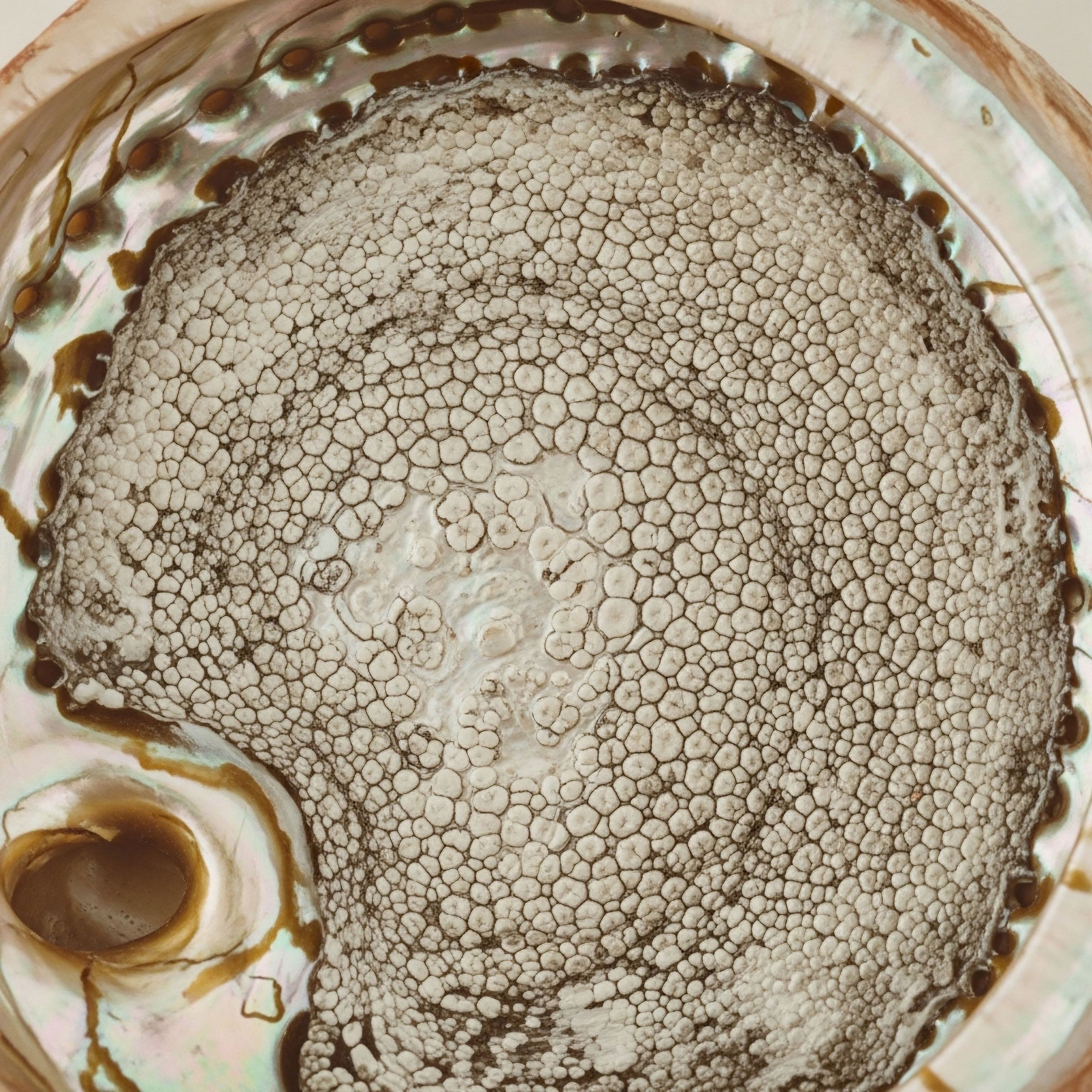

Fundamentals
When you experience a persistent feeling of being “off,” a subtle yet pervasive decline in your vitality, it can be disorienting. Perhaps your energy levels have dwindled, your sleep patterns feel disrupted, or your physical resilience seems diminished.
This lived experience, this sense of your body operating below its optimal capacity, is not merely a subjective impression; it often signals a deeper conversation occurring within your biological systems. Your body communicates through an intricate network of chemical messengers, and when these signals falter, the impact on your daily function becomes undeniable.
Peptide injections represent a precise method of re-establishing clear communication within these biological networks. Peptides are short chains of amino acids, acting as highly specific signaling molecules. They direct cellular activities, influencing everything from tissue repair to metabolic regulation and hormonal balance. Understanding how quickly you might observe changes from these targeted interventions requires acknowledging the body’s inherent wisdom and its capacity for recalibration. It is not an instantaneous transformation, but rather a progressive restoration of internal equilibrium.
Peptide injections serve as precise biological messengers, guiding cellular functions to restore internal balance and vitality.

Understanding Biological Responsiveness
The timeline for observing changes following peptide administration is highly individual, reflecting the unique biochemical landscape of each person. Factors such as your baseline health status, the specific peptide being utilized, the dosage, and the consistency of administration all play a significant role.
Consider your body as a complex biological orchestra; when certain sections are out of tune, reintroducing the correct notes through peptides helps the entire ensemble harmonize. This process takes time, as cells must respond, adapt, and then express the desired physiological changes.
Initial sensations might be subtle, perhaps a slight improvement in sleep quality or a gentle shift in mood. These early indicators often precede more noticeable physical changes. The body prioritizes foundational repairs before manifesting outward improvements. Patience and consistent adherence to the prescribed protocol are paramount, allowing your internal systems the necessary duration to respond and integrate the new biochemical directives.

The Role of Individual Physiology
Your genetic predispositions, lifestyle choices, and the presence of any underlying health conditions significantly influence how your body processes and responds to peptide therapy. A robust metabolic system, for instance, may process and utilize peptides more efficiently, potentially leading to a quicker onset of observable changes.
Conversely, chronic inflammation or significant metabolic dysregulation could extend the period before tangible benefits become apparent. The goal is always to support the body’s inherent capacity for self-regulation, providing the precise signals it requires to optimize function.
The journey toward restored vitality is a collaborative effort between the targeted intervention and your body’s intrinsic healing mechanisms. Peptides act as catalysts, guiding your cells toward more efficient and balanced operation. The initial weeks often involve a foundational re-patterning at the cellular level, setting the stage for more pronounced physiological shifts in the subsequent months.


Intermediate
The application of specific peptide protocols is a precise science, designed to address distinct physiological needs. When considering how quickly you might observe results from peptide injections, it becomes essential to differentiate between the various agents and their primary mechanisms of action. Each peptide acts as a key, unlocking a particular cellular pathway, and the speed of the lock’s response varies.

Growth Hormone Peptide Therapy Protocols
Growth hormone-releasing peptides (GHRPs) and growth hormone-releasing hormones (GHRHs) stimulate the body’s natural production of growth hormone. This approach avoids exogenous growth hormone administration, instead prompting the pituitary gland to release its own stores. The benefits associated with optimized growth hormone levels, such as improved body composition, enhanced recovery, and better sleep quality, tend to unfold over a period of weeks to months.
Growth hormone-releasing peptides stimulate the body’s own growth hormone production, with benefits appearing over weeks to months.
Commonly utilized peptides in this category include:
- Sermorelin ∞ A GHRH analog, Sermorelin encourages the pituitary to release growth hormone. Individuals often report improvements in sleep quality within the first few weeks, followed by subtle shifts in body composition and recovery over 1-3 months.
- Ipamorelin and CJC-1295 ∞ These are often combined. Ipamorelin is a GHRP, while CJC-1295 (without DAC) is a GHRH analog. Their synergistic action leads to a sustained, pulsatile release of growth hormone. Initial improvements in sleep and general well-being can be observed within 2-4 weeks, with more significant changes in muscle mass, fat reduction, and skin elasticity becoming apparent after 2-6 months of consistent use.
- Tesamorelin ∞ This GHRH analog is particularly noted for its targeted effect on visceral fat reduction. While some individuals report increased energy within a month, measurable reductions in abdominal fat typically require 3-6 months of consistent administration.
- Hexarelin ∞ A potent GHRP, Hexarelin can offer rapid increases in growth hormone levels. Users might experience enhanced appetite and initial strength gains within weeks, with more comprehensive body composition changes developing over 2-4 months.
- MK-677 (Ibutamoren) ∞ While not an injectable peptide, MK-677 is an oral growth hormone secretagogue. It stimulates growth hormone release by mimicking ghrelin. Similar to injectables, sleep improvements can be noted within weeks, with body composition and recovery benefits appearing over 2-6 months.

Other Targeted Peptide Applications
Beyond growth hormone optimization, other peptides address specific physiological pathways, each with its own response timeline.

How Do Peptides Influence Tissue Repair and Recovery?
For tissue repair and anti-inflammatory effects, peptides like Pentadeca Arginate (PDA) are gaining recognition. PDA is a synthetic peptide derived from a naturally occurring protein, involved in cellular repair and inflammation modulation.
Individuals utilizing PDA for injury recovery or chronic inflammatory conditions might experience reduced discomfort and improved mobility within 2-4 weeks, with more complete tissue regeneration taking several months, depending on the severity and chronicity of the condition. The mechanism involves direct interaction with cellular repair pathways, accelerating the body’s natural healing cascade.
Another specialized peptide, PT-141 (Bremelanotide), targets sexual health. This peptide acts on melanocortin receptors in the central nervous system, influencing sexual desire and arousal. Its effects are often quite rapid, with some individuals experiencing a response within 30 minutes to a few hours of administration. This quick onset is due to its direct neurological action, bypassing the slower processes of hormonal rebalancing.
The table below provides a general overview of expected timelines for various peptide therapies, recognizing that individual responses will vary.
| Peptide Category | Primary Benefit | Initial Observable Changes | More Significant Changes |
|---|---|---|---|
| Growth Hormone Secretagogues (e.g. Sermorelin, Ipamorelin/CJC-1295) | Improved Sleep, Recovery, Body Composition | 2-4 Weeks (Sleep, Energy) | 2-6 Months (Muscle, Fat Loss, Skin) |
| Tissue Repair Peptides (e.g. Pentadeca Arginate) | Reduced Inflammation, Accelerated Healing | 2-4 Weeks (Pain Reduction, Mobility) | 2-6 Months (Tissue Regeneration) |
| Sexual Health Peptides (e.g. PT-141) | Enhanced Libido, Arousal | 30 Minutes – 4 Hours | Consistent Response with Repeated Use |
The consistency of administration, adherence to dosage protocols, and concurrent lifestyle factors such as nutrition, exercise, and stress management significantly influence the speed and magnitude of results. Peptides are powerful tools, yet they function optimally within a supportive physiological environment.


Academic
Understanding the timeline for observing changes from peptide injections necessitates a deep appreciation for the intricate interplay of biological axes and cellular signaling pathways. The body’s endocrine system operates as a sophisticated communication network, where peptides serve as highly specific molecular messengers, influencing cellular behavior and systemic equilibrium. The speed of response is not merely a function of the peptide’s presence, but rather its integration into complex feedback loops and metabolic cascades.

The Hypothalamic-Pituitary-Gonadal Axis and Peptide Influence
Consider the Hypothalamic-Pituitary-Gonadal (HPG) axis , a central regulatory system governing reproductive and hormonal health. Peptides such as Gonadorelin, a synthetic analog of gonadotropin-releasing hormone (GnRH), directly stimulate the pituitary gland to release luteinizing hormone (LH) and follicle-stimulating hormone (FSH). This stimulation, in turn, prompts the gonads (testes in men, ovaries in women) to produce testosterone or estrogen.
In the context of male hormone optimization, particularly for individuals undergoing or discontinuing Testosterone Replacement Therapy (TRT), Gonadorelin is employed to maintain testicular function and endogenous testosterone production. While the biochemical response of LH and FSH secretion can be observed in laboratory markers within days, the physiological manifestation of sustained testicular function and improved fertility may require several weeks to months.
This delay reflects the cellular processes involved in spermatogenesis and steroidogenesis, which are not instantaneous. Clinical studies indicate that improvements in sperm parameters, for instance, often require at least 3-6 months of consistent Gonadorelin administration.
The body’s intricate endocrine system processes peptide signals, influencing the timeline for observable physiological changes.

Peptide Modulation of Metabolic Pathways
The impact of peptides extends beyond direct hormonal stimulation, influencing broader metabolic function. Growth hormone-releasing peptides, for example, do not simply increase circulating growth hormone; they modulate downstream metabolic pathways. Growth hormone itself influences lipid metabolism, protein synthesis, and glucose homeostasis. The observable changes in body composition ∞ such as reductions in adipose tissue and increases in lean muscle mass ∞ are the cumulative result of these sustained metabolic shifts.
Research on Tesamorelin, a GHRH analog, highlights its specific action on visceral adipose tissue. Its mechanism involves enhancing lipolysis and reducing triglyceride synthesis in visceral fat cells, mediated by changes in gene expression and enzyme activity.
While some individuals report subjective improvements in energy within weeks, the statistically significant reduction in visceral fat area, as measured by DEXA scans, typically requires a minimum of 26 weeks of treatment. This timeline underscores the necessity of sustained biochemical signaling to induce structural and functional changes in metabolic tissues.

Cellular Repair and Inflammatory Modulation
Peptides like Pentadeca Arginate (PDA) offer insights into the complexities of tissue repair and inflammation. PDA is a synthetic peptide that interacts with specific cellular receptors to promote angiogenesis, extracellular matrix remodeling, and anti-inflammatory responses. Its action is rooted in its ability to influence growth factor signaling and cytokine production at the cellular level.
The initial reduction in localized inflammation or pain, often reported within weeks, reflects the immediate modulation of inflammatory mediators. However, the more profound benefits of tissue regeneration, such as improved collagen synthesis in tendons or cartilage, are contingent upon cellular proliferation and matrix deposition, processes that unfold over months. Studies investigating similar regenerative peptides in musculoskeletal injuries often report significant structural improvements only after 3-6 months of consistent application, emphasizing the biological time required for cellular turnover and tissue remodeling.
The table below illustrates the typical progression of effects from peptide therapy, from initial biochemical shifts to sustained physiological adaptations.
| Phase of Response | Typical Timeline | Physiological Manifestation | Underlying Mechanism |
|---|---|---|---|
| Initial Biochemical Shift | Days to 2 Weeks | Subtle changes in mood, sleep, energy; altered lab markers (e.g. LH, FSH, IGF-1) | Receptor binding, immediate signaling cascade activation, acute hormone release |
| Early Physiological Adaptation | 2-8 Weeks | Improved recovery, reduced minor discomfort, initial body composition shifts | Gene expression modulation, enzyme activity changes, early cellular repair processes |
| Sustained Structural & Functional Change | 2-6+ Months | Significant body composition changes, tissue regeneration, sustained vitality | Cellular proliferation, tissue remodeling, long-term metabolic recalibration |
The individual’s baseline health, genetic polymorphisms affecting receptor sensitivity or enzyme activity, and adherence to lifestyle recommendations (e.g. nutritional support, adequate sleep, stress management) are all critical determinants of the rate and extent of response. Peptide therapy is a sophisticated intervention that leverages the body’s inherent capacity for self-optimization, but this optimization is a process, not an event.

References
- Liu, P. Y. & Handelsman, D. J. (2003). The effect of gonadotropin-releasing hormone (GnRH) on testicular function in men. Journal of Clinical Endocrinology & Metabolism, 88(12), 5621-5628.
- Falutz, J. Mamputu, J. C. & Routhier, E. (2010). Effects of tesamorelin (TH9507), a growth hormone-releasing factor analogue, in patients with HIV-associated lipodystrophy ∞ a randomized, double-blind, placebo-controlled trial. Journal of Acquired Immune Deficiency Syndromes, 54(3), 272-280.
- Zhang, J. & Wang, Y. (2014). Growth factors and their application in tendon and ligament healing. Frontiers in Bioscience (Elite Edition), 6(1), 104-117.
- Yuen, K. C. J. & Biller, B. M. K. (2012). Growth hormone and body composition. Journal of Clinical Endocrinology & Metabolism, 97(12), 4323-4330.
- Veldhuis, J. D. & Bowers, C. Y. (2003). Human growth hormone-releasing hormone and growth hormone-releasing peptides ∞ an update. Journal of Clinical Endocrinology & Metabolism, 88(12), 5629-5638.
- Handelsman, D. J. & Inder, W. J. (2013). Testosterone and the male reproductive system. In Endocrinology ∞ Adult and Pediatric (7th ed. pp. 2197-2224). Saunders.
- Shimon, I. & Melmed, S. (2008). Acromegaly and growth hormone excess. In Williams Textbook of Endocrinology (11th ed. pp. 227-264). Saunders.
- Bhasin, S. & Jasuja, R. (2010). Regulation of lean body mass and muscle function by androgens. Current Opinion in Clinical Nutrition and Metabolic Care, 13(3), 232-239.

Reflection
As you consider the insights shared regarding peptide injections and their influence on your biological systems, reflect on your own health narrative. What sensations or shifts have you observed in your body that might signal a need for deeper understanding? This knowledge is not merely academic; it is a lens through which you can begin to interpret your own unique biological signals.
The path toward reclaiming vitality is deeply personal, a continuous dialogue between your body’s inherent wisdom and targeted, evidence-based interventions. Understanding the nuanced timelines and mechanisms of peptide therapy is a significant step, yet it is just one component of a comprehensive approach to wellness. Your journey is unique, and the most effective strategies will always be those precisely tailored to your individual physiological blueprint.

What Does Personalized Wellness Truly Mean?
Consider how the principles of precise biochemical signaling apply to your broader health goals. The information presented here serves as a foundation, inviting you to engage more deeply with your own internal processes. True wellness involves a continuous process of learning, adapting, and optimizing, guided by both scientific understanding and an attuned awareness of your body’s responses.



